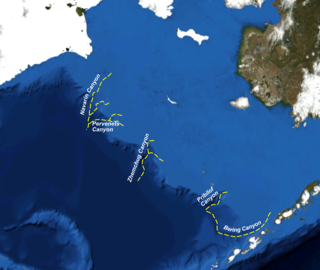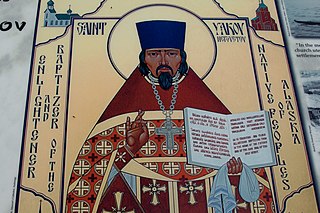
The Aleuts, who are usually known in the Aleut language by the endonyms Unangan, Unangas, Унаӈан, are the indigenous people of the Aleutian Islands.

The Eskimo–Aleut, Inuit–Yupik–Unangan, or Eskaleut languages are a language family native to Alaska, Nunavut, northern Northwest Territories, northern Quebec (Nunavik), northern Labrador (Nunatsiavut), Greenland and far eastern Russia. It is also known as Eskaleutian, Eskaleutic or Inuit–Yupik–Unangan.

Attu is an island in the Near Islands. It is the westernmost point of the U.S. state of Alaska. The island became uninhabited in 2010, making it the largest uninhabited island in the United States.

Bentwood objects are those made by wetting wood, then bending it and letting it harden into curved shapes and patterns.

Zhemchug Canyon is an underwater canyon located in the middle of the Bering Sea. It is the deepest submarine canyon in the world, and is also tied for the widest.

The baidarka or Aleutian kayak is a watercraft consisting of soft skin over a rigid space frame. Its initial design was created by the native Aleut people of the Aleutian Islands. The Aleut people were surrounded by treacherous waters and required water transportation and a hunting vessel. Due to the geography and climate of the Aleutian Islands, trees and wood were in scarce supply and the people relied primarily on driftwood to create the framework of the kayak, which was covered with the skins of sea mammals. Two types of boats were created, one with a covered deck that was used as a hunting kayak, and another that was open and capable of carrying goods and people from one island to another.

The umbrella slug is a species of large sea snail or limpet, a marine gastropod mollusc in the family Umbraculidae. It is found in tropical to warm temperate parts of the Indo-Pacific and Atlantic Oceans, where it feeds on sponges.

Davidson Seamount is a seamount located off the coast of Central California, 80 mi (129 km) southwest of Monterey and 75 mi (121 km) west of San Simeon. At 26 mi (42 km) long and 8 mi (13 km) wide, it is one of the largest known seamounts in the world. From base to crest, the seamount is 7,480 ft (2,280 m) tall, yet its summit is still 4,101 ft (1,250 m) below the sea surface. The seamount is biologically diverse, with 237 species and 27 types of deep-sea coral having been identified.

Unalaska is a volcanic island in the Fox Islands group of the Aleutian Islands in the US state of Alaska located at 53°38′N167°00′W. The island has a land area of 1,051 square miles (2,720 km2). It measures 79.4 mi (127.8 km) long and 34.7 mi (55.8 km) wide. The city of Unalaska, Alaska, covers part of the island and all of neighboring Amaknak Island where the Port of Dutch Harbor is located. The population of the island excluding Amaknak as of the 2000 census was 1,759 residents.

Saint Jacob Netsvetov, Enlightener of Alaska, was a native of the Aleutian Islands who became a priest of the Orthodox Church and continued the missionary work of St. Innocent among his and other Alaskan people. His feast day is celebrated on the day of his repose, July 26.

Sergie Sovoroff was an Aleut educational leader. He was born on Umnak Island in the Aleut village of Nikolski in 1902. Sovoroff was born only nine years before the United States government outlawed sea otter hunting. After 1911, the need and use of iqya-x, Aleut sea kayaks, declined abruptly. But Sovoroff continued to see a need for creating model sea kayaks, known in his days by the Russian name "baidarka". Sovoroff "...kept up the tradition of making kayak models". Model sea kayaks built by Sovoroff, quite often with three hatches with a Russian Orthodox priest seated in the middle hatch, can be seen in many museums around the world. These model sea kayaks, finely crafted by Sovoroff, often equipped with a rudder on the stern of the kayak, all too frequently bear the name of the person who purchased them or donated them to the museum, and not Sovoroff's.

Andrew Gronholdt was a famous Aleut from Sand Point, Alaska, in the Shumagin Islands south of the lower Alaska Peninsula and became famous for rejuvenating the ancient Unangan art of carving hunting hats called chagudax. In January 2012, a book was published posthumously by Gronholdt titled "Chagudax: A Small Window into the Life of An Aleut Bentwood Hat Carver" Gronholdt's woodworking techniques, wood steaming and bending methods, and instructional design methodologies were legendary.

The Aleutian Islands, also called the Aleut Islands or Aleutic Islands and known before 1867 as the Catherine Archipelago, are a chain of 14 large volcanic islands and 55 smaller islands. Most of the Aleutian Islands belong to the U.S. state of Alaska, but some belong to the Russian federal subject of Kamchatka Krai. They form part of the Aleutian Arc in the Northern Pacific Ocean, occupying an area of 6,821 sq mi (17,666 km2) and extending about 1,200 mi (1,900 km) westward from the Alaska Peninsula toward the Kamchatka Peninsula in Russia, and act as a border between the Bering Sea to the north and the Pacific Ocean to the south. Crossing longitude 180°, at which point east and west longitude end, the archipelago contains both the westernmost part of the United States by longitude and the easternmost by longitude. The westernmost U.S. island in real terms, however, is Attu Island, west of which runs the International Date Line. While nearly all the archipelago is part of Alaska and is usually considered as being in the "Alaskan Bush", at the extreme western end, the small, geologically related Commander Islands belong to Russia.

Placopecten magellanicus, previously listed as Pecten tenuicostatus and as Pecten grandis and once referred to as the "giant scallop", common names Atlantic deep-sea scallop, deep sea scallop, North Atlantic sea scallop, American sea scallop, Atlantic sea scallop, or sea scallop, is a commercially important pectinid bivalve mollusk native to the northwest Atlantic Ocean.
Aaptos is a genus of sea sponges in the family Suberitidae.
Aaptos papillata is a species of sea sponge belonging to the family Suberitidae. This species was first described in 1880. It is native to the northeastern Atlantic Ocean, the English Channel and the Mediterranean Sea.
Aaptos robustus is a species of sea sponge belonging to the family Suberitidae. The species was described in 2008.

Chondrocladia lyra, also known as the lyre sponge or harp sponge, is a species of carnivorous deep-sea sponge first discovered off the Californian coast living at depths of 10,800–11,500 feet (3,300–3,500 m) by Welton L. Lee, Henry M Reiswig, William C. Austin, and Lonny Lundsten from the Monterey Bay Aquarium Research Institute (MBARI).

Unangan hunting headgear are wooden hats associated with the Unangan, the Indigenous peoples of what are currently known as the Aleutian Islands.

Stephan Gavrilovich Glotov was a Russian navigator, explorer, and fur trader. He was the first Russian captain to enter the waters of the eastern Aleutian Islands, and was the European discoverer of Kodiak Island and several other Alaskan islands.
















